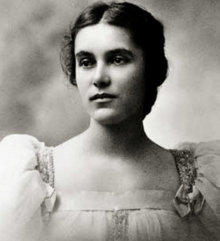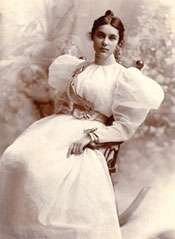Anita Florence Hemmings
Anita Florence Hemmings (June 8, 1872 – 1960) was the first African-American woman to graduate from Vassar College.[1] After graduation she became a librarian at the Boston Public Library.
Anita Florence Hemmings | |
|---|---|
 | |
| Born | June 8, 1872 Boston, Massachusetts, U.S. |
| Died | 1960 (aged 87–88) New York City, New York, U.S. |
| Alma mater | Vassar College |
| Occupation | Librarian |
| Spouse(s) | Andrew Love ( m. 1903) |
| Children | 3 |
| Part of a series on | ||||||||||||
| African Americans | ||||||||||||
|---|---|---|---|---|---|---|---|---|---|---|---|---|
|
||||||||||||
|
||||||||||||
|
Religion
|
||||||||||||
|
Politics
|
||||||||||||
|
Civic / economic groups
|
||||||||||||
|
Sports
|
||||||||||||
|
Sub-communities
|
||||||||||||
|
Dialects and languages
|
||||||||||||
|
Population
|
||||||||||||
| ||||||||||||
Personal life
Anita Hemmings was born June 8, 1872, in Boston to Dora Logan (maiden; 1856–1941) and Robert Williamson Hemmings, Sr. (1843–1908). Anita was an Episcopalian.
Husband
Anita married Andrew Love, MD (né Andrew Jackson Love; 1861–1948), on October 20, 1903, in Boston at Trinity Church. Their marriage license indicates their race as African American. About thirteen years earlier, in 1890, Love earned a medical degree from the Meharry Medical Department of Central Tennessee College in Nashville,[2] an institution distinguished for, among other things, having the first medical school in the South for African Americans.[3] Dr. Love did post-graduate studies at Harvard Medical School in the summer of 1905.[4][5]
Children
- Ellen Parker Love (1905–1995), a 1927 graduate of Vassar, who on June 6, 1934, in Manhattan, married Charles Beckinton Atkin (1906–1987).
- Barbara Hope Love (1907–2007), who on June 9, 1930, in Manhattan, married William Adair Hurt (1907–1965). They later divorced.
- Andrew Jackson Love, Jr. (1911–1982), who attended the Horace Mann School until around 1937, then transferred to the Mount Herman School in Northfield, Massachusetts – the sister school of his mother's alma mater – graduating around 1930[6] studied pre-med at the University of Wisconsin for two years (1930 and 1931), then went on to become an acclaimed jazz vocalist – notably as founder of the jazz trio, the Tune Twisters, which recorded, around 1939, a nationally popular jingle for Pepsi, an innovation in broadcast advertising and considered one of the first of its kind.
Siblings
- Elizabeth "Libby" N. Hemings (born 1876) married Walter Gilbert Alexander, MD (1880–1953), on May 3, 1904, in Boston. They later divorced. Elizabeth died in an asylum. Records reflect that she was clinically insane.
- Frederick John Hemmings (né Frederic Henderson Hemmings; 1873–1956), earned a bachelor's degree chemistry from MIT in 1897.[7]
- Robert Williamson Hemmings, Jr. (born 1882), was an artist who studies in art included winning, in 1903, a bronze medal and scholarship from the Eric Pape School of Art for a sketch in black and white. He graduated June 26, 1899, from the Sherwin School's 26th class, a high school for African Americans in Roxbury.[8]
Secondary and higher education

Anita Hemmings attended preparation school at Girls' High School in Boston and Northfield, where she had been roommates with Elizabeth Baker (maiden; 1868–1943), who, on September 23, 1896, married William Henry Lewis (1868–1949). Fulfilling a childhood dream,[11] Anita went on to attend Vassar, and earned a bachelor of arts degree in 1897. She apparently attended as a white, something that was not known until her graduation, when a Boston newspaper – commenting on the graduation of an African American, Fred J. Hemmings, from MIT – stated that he had a sister at Vassar.
Later, rumors circulated that she should have been valedictorian, but they were false. Some considered Anita the most attractive woman in her class; it was whispered that she had 'Indian blood' which accounted for her dark-hued complexion and straight black hair. She sang soprano in the glee club and was the featured soloist at the local churches in Poughkeepsie.[12]
In 1997, Vassar African-American studies students petitioned college president Frances D. Fergusson to recognize Anita Hemmings at that year's centennial celebration. Writing about it in Vassar Quarterly, Olivia Mancini, a local journalist, argued: "It brought [Hemmings’] graduation and presence to a level of honor that it should have had a hundred years ago." Vassar has acknowledged Anita Hemmings as the first African American to graduate the college, but for almost all of her college career, she 'passed' as white.
In popular culture
In November 2017, it was announced that Zendaya will produce and star in a biopic of Hemmings' life titled A White Lie, based on the 2016 novel The Gilded Years by Karin Tanabe.[11] Reese Witherspoon will also produce the project and Monica Beletsky will write the script. TriStar Pictures will distribute the film.
See also
Biographies of other multi-racial people
Film
- Multi-Facial, 1995 film
Filmmakers
Literature
- Passing, 1929 novel
- The Autobiography of an Ex-Colored Man, 1912 fictional novel
Terminology
References
- "Dark, But Beautiful: Colored Girl Went Through Exclusive Vassar College – Her Secret Not Guessed Until After Graduation, and She Got Her Diploma – She Hailed From Boston," Boston Globe, Vol. 52, No. 47. August 16, 1897, p. 1 (accessible via Newspapers.com, subscription required)Note: The offensive tenor of the headline ("Black, But Beautiful ... ") and vernacular of article is a noteworthy window into the bigotry of journalism of the era, and white society itself. The Boston Globe was a major voice in North America; i.e., one that reflected perceived social norms, and one of myriad possible seemingly authoritative influences that showered Ms. Hemmings. The author likely thought that they were generously lauding Ms. Hemmings for possessing (i) beauty deemed, in the day, as exceptional by whites and (ii) the upbringing, academic preparation, and intellectual tenacity to excel in an exclusive institution of higher education – something that was rare, especially for women. The bigotry exhibited in the article perhaps highlights the trickiness of values and aspirations harbored by Ms. Hemmings in the face of polar trade-offs – especially given that attending Vassar College had been a childhood dream, a dream elevated into reality with encouragement from another influential woman.(because this Boston Globe citation overtly supports the prior statement, perhaps no citation is needed: Sep 2019)
- Medical and Surgical Register of the United States (4th ed., rev.), R.L. Polk & Co. (1896); "Love, Andrew J. (R) 302, '90" (302 is the code for Meharry Medical Department, Central Tennessee College; see p. 127); '90" p. 1385
- Twenty-Ninth Annual Catalogue and Quadrennial Year Book, Central Tennessee College, 1894–1895, p. 54
- Mancini, Olivia (2002). "Passing as White: Anita Hemmings 1897". Vassar, the Alumnae/i Quarterly. Vol. 98 no. 1. Retrieved April 29, 2015.
- Against all Odds: The Legacy of Students of African Descent at Harvard Medical School Before Affirmative Action, 1850–1968, by Nora Nouritza Nercessian, "African-American Health Community in Boston in the Early 20th Century," Appendix C: "Postgraduate Students of African Descent at Harvard Medical School 1873–1968" Harvard Medical School, publisher, 2004, pps. 280 & 287; OCLC 645834943 )
- The Gilded Years, by Karin Tanabe, Simon and Schuster (2016); OCLC 983203647
- "Frederick John Hemmings". MIT Black History. Retrieved March 28, 2019.
- "Music and Art," The Crisis, Vol. 8, No. 3, July 1914, p. 111
- Sim, Jillian A. (née Jillian Clare Atkin; born 1969) (March 1999). "Fading To White". American Heritage. Vol. 50 no. 1. Archived from the original on March 28, 2019. Retrieved July 11, 2015.
- Haynes, Monica L. (October 26, 2003). "Passing: How posing as white became a choice for many black Americans". Pittsburgh Post-Gazette. Archived from the original on March 15, 2012. Retrieved April 30, 2015.
- "Hiding from One's True Self" (book review of The Gilded Age), by Terri Schlichenmeyer, Washington Informer, July 14, 2016 (accessible via ProQuest 1806088789, subscription required)
- "Passing For White". Panache Report. Retrieved April 30, 2015.
- Lukasik, Gail (October 17, 2017). White Like Her: My Family's Story of Race and Racial Passing. Skyhorse. ISBN 978-1-51072-412-9.
External links
- Leonard, John William (1914). Woman's Who's Who of America: A Biographical Dictionary of Contemporary Women of the United States and Canada, 1914-1915. American Commonwealth Company.
- Sim, Jillian A. (March 1999). "Fading To White". American Heritage. Vol. 50 no. 1.
- Leads, Abbie (November 30, 2011). "Re: (?Andrew) Jackson Love". Genealogy.com.